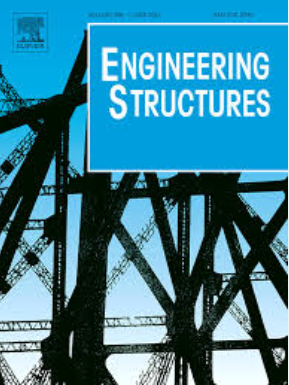桁架钢管混凝土混合结构偏心受压性能研究
IF 6.4
1区 工程技术
Q1 ENGINEERING, CIVIL
引用次数: 0
摘要
本文对受偏心压缩作用的桁架钢管混凝土混合结构进行了研究。共测试了21个不同截面形状、腹板类型、屈服强度、等效长细比和荷载偏心比的试件。在试验研究的基础上,阐明了这些参数对桁架CFST混合结构压弯性能的影响,总结了典型的荷载-应变关系和破坏模式。随着载荷偏心比的增大,偏心受压试件的承载能力和弹性刚度均降低。建立并验证了偏心受压下桁架CFST混合动力结构的有限元分析模型,进行了内力分析、应力分析和参数分析,揭示了其内力和应力的分布规律。通过参数分析发现,载荷偏心比的影响与其他参数无关。考虑偏心比对轴压承载力的降低作用,提出了偏心受压下桁架CFST混合动力结构承载力的简化计算模型。本文章由计算机程序翻译,如有差异,请以英文原文为准。
Performance of trussed concrete-filled steel tubular (CFST) hybrid structures subjected to eccentric compression
This paper presented an investigation on the trussed concrete-filled steel tubular (CFST) hybrid structures subjected to eccentric compression. A total of 21 specimens with varied cross-sectional shapes, web types, yield strength of steel, equivalent slenderness ratios, and load eccentricity ratios were tested. Based on experimental research, the effects of these parameters on the compression-bending performance of the trussed CFST hybrid structure were clarified, and the typical load-strain relations and the failure modes were summarized. As the load eccentricity ratio increased, both the load-bearing capacity and the elastic stiffness of the specimen subjected to eccentric compression decreased. A finite element analysis modelling of trussed CFST hybrid structure subjected to eccentric compression was developed and validated, followed by internal force analysis, stress analysis, and parameter analysis, revealing the distribution patterns of internal forces and stresses. Based on parameter analysis, it was found that the effects of the load eccentricity ratio were independent of those of other parameters. By considering the reduction effect of load eccentricity ratio on the axial compression load-bearing capacity, a simplified calculating model for the load-bearing capacity of trussed CFST hybrid structures subjected to eccentric compression was proposed.
求助全文
通过发布文献求助,成功后即可免费获取论文全文。
去求助
来源期刊

Engineering Structures
工程技术-工程:土木
CiteScore
10.20
自引率
14.50%
发文量
1385
审稿时长
67 days
期刊介绍:
Engineering Structures provides a forum for a broad blend of scientific and technical papers to reflect the evolving needs of the structural engineering and structural mechanics communities. Particularly welcome are contributions dealing with applications of structural engineering and mechanics principles in all areas of technology. The journal aspires to a broad and integrated coverage of the effects of dynamic loadings and of the modelling techniques whereby the structural response to these loadings may be computed.
The scope of Engineering Structures encompasses, but is not restricted to, the following areas: infrastructure engineering; earthquake engineering; structure-fluid-soil interaction; wind engineering; fire engineering; blast engineering; structural reliability/stability; life assessment/integrity; structural health monitoring; multi-hazard engineering; structural dynamics; optimization; expert systems; experimental modelling; performance-based design; multiscale analysis; value engineering.
Topics of interest include: tall buildings; innovative structures; environmentally responsive structures; bridges; stadiums; commercial and public buildings; transmission towers; television and telecommunication masts; foldable structures; cooling towers; plates and shells; suspension structures; protective structures; smart structures; nuclear reactors; dams; pressure vessels; pipelines; tunnels.
Engineering Structures also publishes review articles, short communications and discussions, book reviews, and a diary on international events related to any aspect of structural engineering.
 求助内容:
求助内容: 应助结果提醒方式:
应助结果提醒方式:


